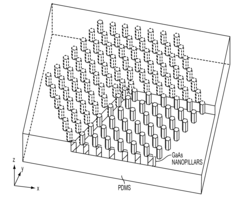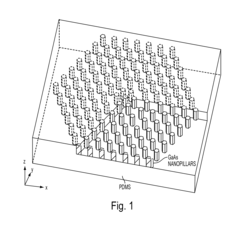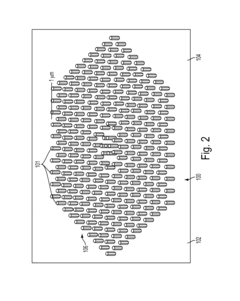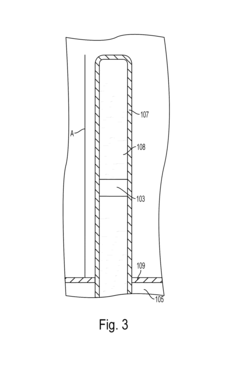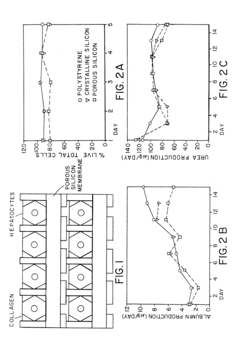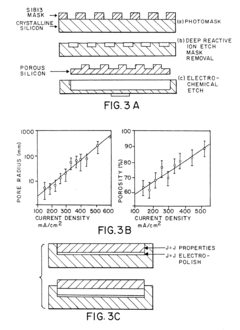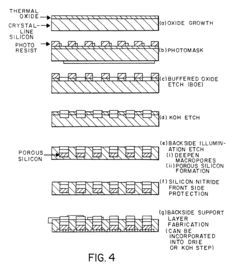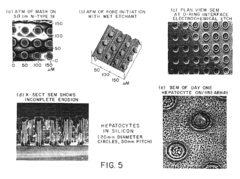Silicon Micropillars for Nanomechanical Testing
JUL 9, 20259 MIN READ
Generate Your Research Report Instantly with AI Agent
Patsnap Eureka helps you evaluate technical feasibility & market potential.
Silicon Micropillar Background and Objectives
Silicon micropillars have emerged as a crucial tool in the field of nanomechanical testing, offering unprecedented insights into material behavior at the micro and nanoscale. The development of these structures can be traced back to the early 2000s when researchers began exploring novel methods to investigate mechanical properties of materials at smaller scales. As the semiconductor industry continued to push the boundaries of miniaturization, the need for understanding material behavior at these scales became increasingly important.
The evolution of silicon micropillars has been closely tied to advancements in microfabrication techniques, particularly focused ion beam (FIB) milling and electron beam lithography. These technologies have enabled the creation of precisely controlled micropillar geometries, typically ranging from hundreds of nanometers to a few micrometers in diameter. The ability to fabricate such structures with high precision has opened up new avenues for studying size-dependent mechanical properties, deformation mechanisms, and failure modes in materials.
The primary objective of research on silicon micropillars for nanomechanical testing is to bridge the gap between bulk material properties and atomic-scale behavior. By investigating the mechanical response of these microstructures, researchers aim to uncover fundamental material properties that are not observable in bulk samples. This includes phenomena such as size-dependent strengthening, dislocation dynamics, and surface effects on mechanical behavior.
Another key goal is to develop standardized methodologies for nanomechanical testing using silicon micropillars. This involves establishing protocols for sample preparation, testing procedures, and data analysis to ensure reproducibility and comparability of results across different research groups. Standardization is crucial for the widespread adoption of micropillar testing in both academic and industrial settings.
Furthermore, research in this field seeks to expand the application of silicon micropillar testing beyond traditional materials. While initially focused on metals and alloys, recent efforts have extended to ceramics, semiconductors, and even biological materials. This broadening of scope aims to provide a comprehensive understanding of material behavior across various classes of materials at the microscale.
The long-term vision for silicon micropillar research includes the development of predictive models that can accurately describe material behavior from the nanoscale to the macroscale. By correlating experimental data from micropillar tests with multiscale simulations, researchers hope to create powerful tools for materials design and optimization. This could potentially revolutionize fields such as aerospace, microelectronics, and biomedical engineering, where understanding and controlling material properties at small scales is critical for advancing technology.
The evolution of silicon micropillars has been closely tied to advancements in microfabrication techniques, particularly focused ion beam (FIB) milling and electron beam lithography. These technologies have enabled the creation of precisely controlled micropillar geometries, typically ranging from hundreds of nanometers to a few micrometers in diameter. The ability to fabricate such structures with high precision has opened up new avenues for studying size-dependent mechanical properties, deformation mechanisms, and failure modes in materials.
The primary objective of research on silicon micropillars for nanomechanical testing is to bridge the gap between bulk material properties and atomic-scale behavior. By investigating the mechanical response of these microstructures, researchers aim to uncover fundamental material properties that are not observable in bulk samples. This includes phenomena such as size-dependent strengthening, dislocation dynamics, and surface effects on mechanical behavior.
Another key goal is to develop standardized methodologies for nanomechanical testing using silicon micropillars. This involves establishing protocols for sample preparation, testing procedures, and data analysis to ensure reproducibility and comparability of results across different research groups. Standardization is crucial for the widespread adoption of micropillar testing in both academic and industrial settings.
Furthermore, research in this field seeks to expand the application of silicon micropillar testing beyond traditional materials. While initially focused on metals and alloys, recent efforts have extended to ceramics, semiconductors, and even biological materials. This broadening of scope aims to provide a comprehensive understanding of material behavior across various classes of materials at the microscale.
The long-term vision for silicon micropillar research includes the development of predictive models that can accurately describe material behavior from the nanoscale to the macroscale. By correlating experimental data from micropillar tests with multiscale simulations, researchers hope to create powerful tools for materials design and optimization. This could potentially revolutionize fields such as aerospace, microelectronics, and biomedical engineering, where understanding and controlling material properties at small scales is critical for advancing technology.
Market Demand for Nanomechanical Testing
The market demand for nanomechanical testing using silicon micropillars has been steadily growing in recent years, driven by the increasing need for precise material characterization at the nanoscale. This demand spans across various industries, including semiconductor manufacturing, aerospace, automotive, and biomedical engineering.
In the semiconductor industry, the push for smaller and more efficient electronic devices has created a significant need for nanomechanical testing. Silicon micropillars offer a unique solution for evaluating the mechanical properties of thin films and nanostructures used in microchips and other electronic components. This allows manufacturers to optimize their designs and improve the reliability of their products.
The aerospace and automotive sectors are also showing increased interest in nanomechanical testing using silicon micropillars. As these industries continue to develop lightweight and high-strength materials, there is a growing need to understand the mechanical behavior of these materials at the nanoscale. Silicon micropillars provide a means to test the strength, elasticity, and fatigue resistance of advanced alloys and composites used in aircraft and vehicle components.
In the field of biomedical engineering, nanomechanical testing is becoming increasingly important for the development of new biomaterials and medical devices. Silicon micropillars offer a way to evaluate the mechanical properties of materials used in implants, prosthetics, and tissue engineering scaffolds. This information is crucial for ensuring the safety and efficacy of medical devices and treatments.
The global market for nanomechanical testing equipment is expected to grow significantly in the coming years. This growth is fueled by the increasing adoption of nanotechnology across various industries and the need for more precise material characterization techniques. Silicon micropillars, as a specific tool for nanomechanical testing, are likely to see increased demand as part of this broader market trend.
Research institutions and universities are also contributing to the market demand for silicon micropillar-based nanomechanical testing. As more researchers explore the mechanical properties of materials at the nanoscale, there is a growing need for reliable and reproducible testing methods. Silicon micropillars offer a standardized approach that can be used across different research groups and institutions.
The demand for nanomechanical testing using silicon micropillars is also being driven by the development of new materials, such as nanocomposites and metamaterials. These advanced materials often have complex mechanical properties that can only be fully understood through nanoscale testing. Silicon micropillars provide a means to investigate these properties and optimize material designs for specific applications.
In the semiconductor industry, the push for smaller and more efficient electronic devices has created a significant need for nanomechanical testing. Silicon micropillars offer a unique solution for evaluating the mechanical properties of thin films and nanostructures used in microchips and other electronic components. This allows manufacturers to optimize their designs and improve the reliability of their products.
The aerospace and automotive sectors are also showing increased interest in nanomechanical testing using silicon micropillars. As these industries continue to develop lightweight and high-strength materials, there is a growing need to understand the mechanical behavior of these materials at the nanoscale. Silicon micropillars provide a means to test the strength, elasticity, and fatigue resistance of advanced alloys and composites used in aircraft and vehicle components.
In the field of biomedical engineering, nanomechanical testing is becoming increasingly important for the development of new biomaterials and medical devices. Silicon micropillars offer a way to evaluate the mechanical properties of materials used in implants, prosthetics, and tissue engineering scaffolds. This information is crucial for ensuring the safety and efficacy of medical devices and treatments.
The global market for nanomechanical testing equipment is expected to grow significantly in the coming years. This growth is fueled by the increasing adoption of nanotechnology across various industries and the need for more precise material characterization techniques. Silicon micropillars, as a specific tool for nanomechanical testing, are likely to see increased demand as part of this broader market trend.
Research institutions and universities are also contributing to the market demand for silicon micropillar-based nanomechanical testing. As more researchers explore the mechanical properties of materials at the nanoscale, there is a growing need for reliable and reproducible testing methods. Silicon micropillars offer a standardized approach that can be used across different research groups and institutions.
The demand for nanomechanical testing using silicon micropillars is also being driven by the development of new materials, such as nanocomposites and metamaterials. These advanced materials often have complex mechanical properties that can only be fully understood through nanoscale testing. Silicon micropillars provide a means to investigate these properties and optimize material designs for specific applications.
Current Challenges in Silicon Micropillar Fabrication
The fabrication of silicon micropillars for nanomechanical testing faces several significant challenges that researchers and engineers are actively working to overcome. One of the primary difficulties lies in achieving precise dimensional control and uniformity across the micropillars. The size and shape of these structures directly impact their mechanical properties, making consistency crucial for reliable testing results.
Another major challenge is the prevention of surface damage during the fabrication process. Traditional machining techniques can introduce defects and residual stresses, which can significantly alter the mechanical behavior of the micropillars. This necessitates the development of more refined fabrication methods that minimize surface imperfections and maintain the intrinsic properties of the silicon.
The aspect ratio of silicon micropillars presents a further complication. Creating high-aspect-ratio structures with uniform cross-sections throughout their length is technically demanding. As the aspect ratio increases, issues such as tapering and non-uniform etching become more pronounced, potentially compromising the validity of nanomechanical tests.
Material purity and crystallographic orientation control are also critical factors that pose challenges in micropillar fabrication. Impurities or misaligned crystal structures can lead to inconsistent mechanical properties, affecting the reproducibility and reliability of test results. Ensuring high purity and precise orientation control requires sophisticated processing techniques and stringent quality control measures.
The scalability of fabrication processes presents yet another hurdle. While creating individual micropillars with high precision is achievable, scaling up production for large-scale testing or commercial applications remains challenging. Developing methods that can produce large arrays of uniform micropillars efficiently and cost-effectively is an ongoing area of research.
Furthermore, the integration of silicon micropillars with testing equipment and measurement systems poses its own set of challenges. Proper alignment, secure mounting, and accurate force application are critical for obtaining reliable nanomechanical data. Developing robust interfaces between the micropillars and testing apparatus is essential for advancing this field of study.
Lastly, the characterization and quality control of fabricated micropillars remain ongoing challenges. Developing non-destructive evaluation techniques that can assess the structural integrity and dimensional accuracy of micropillars without compromising their usability for subsequent testing is crucial for advancing the reliability and efficiency of nanomechanical studies using silicon micropillars.
Another major challenge is the prevention of surface damage during the fabrication process. Traditional machining techniques can introduce defects and residual stresses, which can significantly alter the mechanical behavior of the micropillars. This necessitates the development of more refined fabrication methods that minimize surface imperfections and maintain the intrinsic properties of the silicon.
The aspect ratio of silicon micropillars presents a further complication. Creating high-aspect-ratio structures with uniform cross-sections throughout their length is technically demanding. As the aspect ratio increases, issues such as tapering and non-uniform etching become more pronounced, potentially compromising the validity of nanomechanical tests.
Material purity and crystallographic orientation control are also critical factors that pose challenges in micropillar fabrication. Impurities or misaligned crystal structures can lead to inconsistent mechanical properties, affecting the reproducibility and reliability of test results. Ensuring high purity and precise orientation control requires sophisticated processing techniques and stringent quality control measures.
The scalability of fabrication processes presents yet another hurdle. While creating individual micropillars with high precision is achievable, scaling up production for large-scale testing or commercial applications remains challenging. Developing methods that can produce large arrays of uniform micropillars efficiently and cost-effectively is an ongoing area of research.
Furthermore, the integration of silicon micropillars with testing equipment and measurement systems poses its own set of challenges. Proper alignment, secure mounting, and accurate force application are critical for obtaining reliable nanomechanical data. Developing robust interfaces between the micropillars and testing apparatus is essential for advancing this field of study.
Lastly, the characterization and quality control of fabricated micropillars remain ongoing challenges. Developing non-destructive evaluation techniques that can assess the structural integrity and dimensional accuracy of micropillars without compromising their usability for subsequent testing is crucial for advancing the reliability and efficiency of nanomechanical studies using silicon micropillars.
Existing Silicon Micropillar Fabrication Methods
01 Fabrication methods for silicon micropillars
Various techniques are employed to create silicon micropillars, including lithography, etching, and deposition processes. These methods allow for precise control over the dimensions and spacing of the micropillars, which directly influence their mechanical properties. Advanced fabrication techniques can produce micropillars with high aspect ratios and tailored surface characteristics.- Fabrication methods for silicon micropillars: Various techniques are employed to create silicon micropillars, including photolithography, etching processes, and deposition methods. These fabrication methods significantly influence the mechanical properties of the resulting structures, allowing for precise control over pillar dimensions, spacing, and surface characteristics.
- Mechanical strength and flexibility of silicon micropillars: Silicon micropillars exhibit unique mechanical properties, including high strength-to-weight ratios and flexibility. These characteristics are influenced by factors such as pillar height, diameter, and aspect ratio. The mechanical behavior of micropillars under different loading conditions is crucial for their application in various fields.
- Surface modifications to enhance mechanical properties: Surface treatments and modifications can significantly alter the mechanical properties of silicon micropillars. Techniques such as chemical functionalization, plasma treatment, and nanoparticle deposition can improve adhesion, wear resistance, and overall mechanical performance of the micropillar structures.
- Characterization techniques for mechanical properties: Various analytical methods are used to assess the mechanical properties of silicon micropillars, including nanoindentation, atomic force microscopy, and in-situ electron microscopy. These techniques provide insights into elastic modulus, hardness, fracture toughness, and deformation mechanisms at the microscale.
- Applications leveraging mechanical properties of silicon micropillars: The unique mechanical properties of silicon micropillars are exploited in diverse applications, including MEMS devices, sensors, energy harvesting systems, and biomedical implants. The combination of high strength, flexibility, and customizable surface properties makes silicon micropillars suitable for a wide range of technological advancements.
02 Mechanical strength and durability of silicon micropillars
The mechanical strength of silicon micropillars is a crucial property that depends on factors such as pillar diameter, height, and crystalline structure. Studies have shown that these micropillars exhibit high compressive and tensile strengths, making them suitable for various applications. The durability of silicon micropillars under different stress conditions is also an important consideration for their practical use.Expand Specific Solutions03 Flexibility and elasticity of silicon micropillars
Silicon micropillars demonstrate unique flexibility and elasticity properties, which are influenced by their geometry and surface modifications. These characteristics allow for the development of flexible electronic devices and sensors. The elastic behavior of silicon micropillars under different loading conditions has been extensively studied to optimize their performance in various applications.Expand Specific Solutions04 Surface properties and functionalization of silicon micropillars
The surface properties of silicon micropillars play a crucial role in their mechanical behavior and interactions with the environment. Various surface modification techniques, such as chemical functionalization and coating, can be applied to enhance specific properties like hydrophobicity or adhesion. These modifications can significantly impact the overall mechanical performance of the micropillars.Expand Specific Solutions05 Applications leveraging mechanical properties of silicon micropillars
The unique mechanical properties of silicon micropillars have led to their use in diverse applications. These include microelectromechanical systems (MEMS), energy harvesting devices, and biomedical sensors. The combination of high strength, flexibility, and customizable surface properties makes silicon micropillars ideal for developing advanced technologies that require precise mechanical control at the microscale.Expand Specific Solutions
Key Players in Nanomechanical Testing Industry
The research on silicon micropillars for nanomechanical testing is in an emerging phase, with growing interest from both academia and industry. The market size is expanding as nanotechnology applications increase across various sectors. While the technology is still developing, it shows promise for advanced materials characterization and mechanical property analysis at the nanoscale. Leading institutions like Peking University, California Institute of Technology, and Zhejiang University are at the forefront of this research, alongside companies such as IBM and Hitachi High-Tech America. The involvement of these diverse players indicates a competitive landscape with potential for significant advancements in nanomechanical testing methodologies and instrumentation.
Peking University
Technical Solution: Peking University has developed a novel approach to silicon micropillar fabrication for nanomechanical testing. Their method involves using focused ion beam (FIB) milling to create precisely controlled micropillars with diameters ranging from 100 nm to 5 μm[1]. The university's research team has also implemented in-situ SEM nanoindentation techniques to study the mechanical properties of these micropillars, including yield strength, elastic modulus, and size-dependent deformation behavior[2]. Additionally, they have explored the use of advanced characterization techniques such as transmission electron microscopy (TEM) to analyze the microstructure and defect evolution in deformed micropillars[3].
Strengths: Precise control over micropillar dimensions, advanced in-situ testing capabilities, and comprehensive microstructural analysis. Weaknesses: Potential for ion implantation during FIB milling, which may affect mechanical properties.
The Regents of the University of California
Technical Solution: The University of California has made significant contributions to silicon micropillar research for nanomechanical testing. Their approach involves using a combination of electron beam lithography and deep reactive ion etching (DRIE) to fabricate high-aspect-ratio silicon micropillars with diameters as small as 50 nm[4]. The research team has developed novel testing methodologies, including microcompression and microtensile tests, to evaluate the mechanical properties of these micropillars under various loading conditions[5]. Furthermore, they have investigated the size-dependent strengthening effects in silicon micropillars and their correlation with dislocation dynamics using advanced simulation techniques[6].
Strengths: High-precision fabrication techniques, diverse testing methodologies, and integration of experimental and computational approaches. Weaknesses: Complexity of the fabrication process may limit large-scale production.
Core Innovations in Silicon Micropillar Design
Nanopillar photonic crystal lasers
PatentInactiveUS20140286367A1
Innovation
- A nanopillar photonic crystal laser is developed using a 'bottom-up' approach with III-V nanopillars, enabling precise control of position and diameter to form a high-Q cavity with simultaneous growth of the active region and photonic band-gap, incorporating a passivation layer to reduce surface recombination and achieve low-threshold single-mode lasing.
Nanoporous silicon support containing macropores for use as a bioreactor
PatentInactiveUS6734000B2
Innovation
- A nanoporous silicon bioreactor is developed, featuring macropores of defined sizes to accommodate cells and nanopores for media passage, allowing for the integration of biosensors and enhanced surface area, which supports the growth and differentiation of primary hepatocytes and other cell types, enabling pseudo-3D interactions and bidirectional mass transfer.
Standardization of Nanomechanical Testing Protocols
The standardization of nanomechanical testing protocols for silicon micropillars is crucial for ensuring reproducibility and comparability of results across different research groups and laboratories. Currently, there is a lack of universally accepted standards for conducting nanomechanical tests on silicon micropillars, which can lead to inconsistencies in data interpretation and difficulties in comparing results from different studies.
To address this issue, several key aspects of the testing process need to be standardized. Firstly, sample preparation techniques should be unified, including the methods for fabricating silicon micropillars with consistent dimensions and surface quality. This may involve standardizing the use of focused ion beam (FIB) milling or other fabrication techniques to create micropillars with well-defined geometries and minimal surface defects.
Secondly, the testing equipment and procedures should be standardized. This includes specifying the type of nanoindentation equipment to be used, the loading rates, and the data acquisition methods. For instance, a consensus on the appropriate indenter tip geometry (e.g., flat punch vs. spherical) for different types of tests should be established. Additionally, guidelines for calibrating the equipment and accounting for machine compliance should be developed to ensure accurate measurements.
Thirdly, data analysis and reporting methods need to be standardized. This involves establishing protocols for calculating mechanical properties such as Young's modulus, yield strength, and strain hardening behavior from the raw load-displacement data. Standardized methods for addressing size effects and accounting for the influence of the substrate on the measured properties should also be developed.
Furthermore, the environmental conditions during testing should be controlled and reported consistently. Factors such as temperature, humidity, and atmospheric composition can significantly affect the mechanical behavior of silicon micropillars, especially at the nanoscale. Standardized protocols should specify the acceptable ranges for these parameters and require their documentation in all published results.
Lastly, the development of reference materials and round-robin testing programs can help validate and refine the standardized protocols. By distributing identical samples to multiple laboratories and comparing the results, the scientific community can identify sources of variability and improve the robustness of the testing methods.
Implementing these standardized protocols will greatly enhance the reliability and comparability of nanomechanical testing results for silicon micropillars. This, in turn, will accelerate progress in understanding the mechanical behavior of these structures and facilitate their integration into various applications, such as microelectromechanical systems (MEMS) and nanoelectronics.
To address this issue, several key aspects of the testing process need to be standardized. Firstly, sample preparation techniques should be unified, including the methods for fabricating silicon micropillars with consistent dimensions and surface quality. This may involve standardizing the use of focused ion beam (FIB) milling or other fabrication techniques to create micropillars with well-defined geometries and minimal surface defects.
Secondly, the testing equipment and procedures should be standardized. This includes specifying the type of nanoindentation equipment to be used, the loading rates, and the data acquisition methods. For instance, a consensus on the appropriate indenter tip geometry (e.g., flat punch vs. spherical) for different types of tests should be established. Additionally, guidelines for calibrating the equipment and accounting for machine compliance should be developed to ensure accurate measurements.
Thirdly, data analysis and reporting methods need to be standardized. This involves establishing protocols for calculating mechanical properties such as Young's modulus, yield strength, and strain hardening behavior from the raw load-displacement data. Standardized methods for addressing size effects and accounting for the influence of the substrate on the measured properties should also be developed.
Furthermore, the environmental conditions during testing should be controlled and reported consistently. Factors such as temperature, humidity, and atmospheric composition can significantly affect the mechanical behavior of silicon micropillars, especially at the nanoscale. Standardized protocols should specify the acceptable ranges for these parameters and require their documentation in all published results.
Lastly, the development of reference materials and round-robin testing programs can help validate and refine the standardized protocols. By distributing identical samples to multiple laboratories and comparing the results, the scientific community can identify sources of variability and improve the robustness of the testing methods.
Implementing these standardized protocols will greatly enhance the reliability and comparability of nanomechanical testing results for silicon micropillars. This, in turn, will accelerate progress in understanding the mechanical behavior of these structures and facilitate their integration into various applications, such as microelectromechanical systems (MEMS) and nanoelectronics.
Environmental Impact of Silicon Micropillar Production
The production of silicon micropillars for nanomechanical testing has significant environmental implications that warrant careful consideration. The manufacturing process involves several stages, each with its own environmental impact. The primary raw material, silicon, is abundant in nature but requires energy-intensive extraction and purification processes. The mining and refining of silicon can lead to habitat disruption, soil erosion, and water pollution if not managed properly.
During the fabrication of silicon micropillars, various chemical processes are employed, including etching and deposition techniques. These processes often utilize hazardous chemicals such as hydrofluoric acid, which can pose risks to both human health and the environment if not handled and disposed of correctly. Proper waste management and treatment systems are crucial to mitigate the potential release of these chemicals into ecosystems.
The production of silicon micropillars also consumes substantial amounts of energy, contributing to greenhouse gas emissions if non-renewable energy sources are used. The precise nature of nanoscale fabrication requires cleanroom environments, which demand significant energy for maintaining controlled temperature, humidity, and air purity. Additionally, the use of specialized equipment like electron microscopes and ion beam systems further increases the energy footprint of the production process.
Water consumption is another environmental concern in silicon micropillar production. Large quantities of ultra-pure water are required for cleaning and processing, potentially straining local water resources. The wastewater generated may contain trace amounts of chemicals and nanoparticles, necessitating advanced treatment methods before release.
On the positive side, the small scale of silicon micropillars means that material usage is relatively low compared to bulk silicon production. Furthermore, the development of more efficient nanomechanical testing methods using silicon micropillars could lead to reduced material waste in various industries by enabling more precise and localized testing of mechanical properties.
As research in this field progresses, there is a growing emphasis on developing more sustainable production methods. This includes exploring alternative etching techniques that use less harmful chemicals, implementing closed-loop systems for water and chemical recycling, and increasing the use of renewable energy sources in manufacturing facilities. Additionally, end-of-life considerations for silicon micropillars and associated testing equipment are becoming more important, with efforts to improve recyclability and reduce electronic waste.
During the fabrication of silicon micropillars, various chemical processes are employed, including etching and deposition techniques. These processes often utilize hazardous chemicals such as hydrofluoric acid, which can pose risks to both human health and the environment if not handled and disposed of correctly. Proper waste management and treatment systems are crucial to mitigate the potential release of these chemicals into ecosystems.
The production of silicon micropillars also consumes substantial amounts of energy, contributing to greenhouse gas emissions if non-renewable energy sources are used. The precise nature of nanoscale fabrication requires cleanroom environments, which demand significant energy for maintaining controlled temperature, humidity, and air purity. Additionally, the use of specialized equipment like electron microscopes and ion beam systems further increases the energy footprint of the production process.
Water consumption is another environmental concern in silicon micropillar production. Large quantities of ultra-pure water are required for cleaning and processing, potentially straining local water resources. The wastewater generated may contain trace amounts of chemicals and nanoparticles, necessitating advanced treatment methods before release.
On the positive side, the small scale of silicon micropillars means that material usage is relatively low compared to bulk silicon production. Furthermore, the development of more efficient nanomechanical testing methods using silicon micropillars could lead to reduced material waste in various industries by enabling more precise and localized testing of mechanical properties.
As research in this field progresses, there is a growing emphasis on developing more sustainable production methods. This includes exploring alternative etching techniques that use less harmful chemicals, implementing closed-loop systems for water and chemical recycling, and increasing the use of renewable energy sources in manufacturing facilities. Additionally, end-of-life considerations for silicon micropillars and associated testing equipment are becoming more important, with efforts to improve recyclability and reduce electronic waste.
Unlock deeper insights with Patsnap Eureka Quick Research — get a full tech report to explore trends and direct your research. Try now!
Generate Your Research Report Instantly with AI Agent
Supercharge your innovation with Patsnap Eureka AI Agent Platform!
